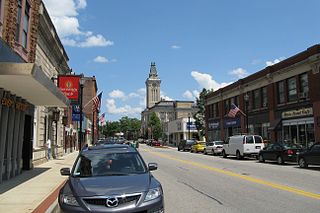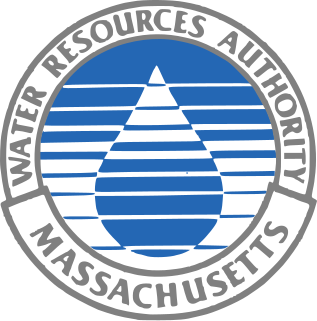
The Assabet River is a small river about 20 miles (30 km) west of Boston, Massachusetts, United States. The river is 34.4 miles (55.4 km) long. OARS: the Organization for the Assabet, Sudbury and Concord Rivers, headquartered in West Concord, Massachusetts, is a non-profit organization dedicated to the preservation, protection, and enhancement of the natural and recreational features of these three rivers and their watershed. The Assabet and Sudbury Rivers merge in Concord to become the Concord River.
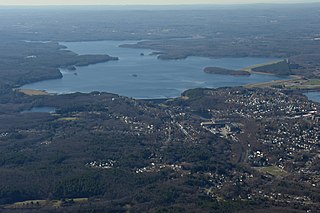
The Wachusett Reservoir is the second largest body of water in the state of Massachusetts. It is located in central Massachusetts, northeast of Worcester. It is part of the water supply system for metropolitan Boston maintained by the Massachusetts Water Resources Authority (MWRA). It has an aggregate capacity of 65 billion US gallons (250,000,000 m3) and an area of almost 7 square miles (18.2 km²). Water from the Wachusett flows to the covered Norumbega Storage Facility via the Cosgrove Tunnel and the MetroWest Water Supply Tunnel. The reservoir has a maximum depth of 120 feet and a mean depth of 48 feet.

This is a list of properties and districts in Massachusetts listed on the National Register of Historic Places. There are over 4,200 listings in the state, representing about 5% of all NRHP listings nationwide and the second-most of any U.S. state, behind only New York. Listings appear in all 14 Massachusetts counties.

The Wachusett Aqueduct is a secondary aqueduct that carries water from the Wachusett Reservoir to the John J. Carroll Water Treatment Plant at Walnut Hill in Marlborough, Massachusetts. It is part of the public water supply system for the communities of Greater Boston that are served by the Massachusetts Water Resources Authority (MWRA), which manages the aqueduct. The aqueduct serves as a standby backup to the Cosgrove Tunnel.
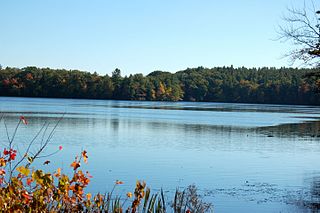
The Quinapoxet River is part of the Nashua River watershed in northern Massachusetts in the United States. It is part of the Massachusetts Water Resources Authority water system supplying drinking water to the greater Boston area.
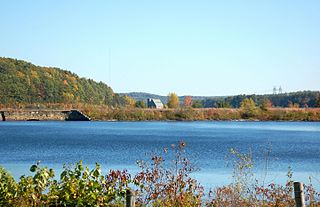
The Stillwater River is part of the Nashua River watershed. This river is part of the Massachusetts Water Resources Authority system that supplies drinking water to the greater Boston area.

The Weston Reservoir is part of the greater Boston water supply maintained by the Massachusetts Water Resources Authority. It is located in central Weston, with its principal public access point on Ash Street.

Chestnut Hill Reservoir is a reservoir created in 1870 on existing marshes and meadowland to supplement the city of Boston's water needs. It is surrounded by Chestnut Hill, a neighborhood which consists of parts of Boston, Brookline, and Newton. The reservoir, though, is located entirely within the city limits of Boston. A 1.56 mile jogging loop abuts the reservoir. Chestnut Hill Reservoir was taken offline in 1978 as it was no longer needed for regular water supply distribution, but is maintained in emergency backup status. It is recognized today on the National Register of Historic Places and it has designation as a City of Boston Landmark.

The Chestnut Hill Reservoir Historic District is a historic district encompassing the Chestnut Hill Reservoir and the surrounding water works facilities which were historically used to provide fresh water to Boston, Massachusetts, and surrounding towns. The district is nearly coextensive with the Chestnut Hill Reservation, a state park managed by the Massachusetts Department of Conservation and Recreation (DCR); those elements of the water works that are still required as an emergency backup are managed by the Massachusetts Water Resources Authority (MWRA). The reservoir is located between Beacon Street and Commonwealth Avenue in Boston, just east of the Boston College Main Campus Historic District and the Boston-Newton city line. Most of the water works facilities are also located in Boston; the terminal house of the Sudbury Aqueduct, which is part of this district, is located just over the line in Newton.

Bellevue Standpipe is a historic water storage tank on Bellevue Hill at Washington Street and West Roxbury Parkway in the Stony Brook Reservation of Boston, Massachusetts. The masonry structure is 114 feet (35 m) tall and 47 feet (14 m) in diameter, built out of rough-cut granite blocks. It was built by the Metropolitan Water and Sewerage Board in 1914 to house a 2.5 million gallon steel water storage tank, as part of the Southern Extra High Service Area. It received water from the Fisher Hill Reservoir in Brookline via a 20-inch main. A second water storage tank was added at this location in 1955-56.
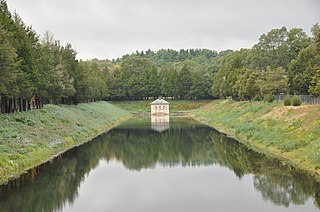
The Weston Aqueduct is an aqueduct operated by the Massachusetts Water Resources Authority. Now part of the MWRA backup systems, it was designed to deliver water from the Sudbury Reservoir in Framingham to the Weston Reservoir in Weston. The 13.5-mile (21.7 km) aqueduct begins at the Sudbury Dam, and passes through the towns of Southborough, Framingham, Wayland, and Weston. In 1990 the route, buildings and bridges of the aqueduct were added to the National Register of Historic Places as the Weston Aqueduct Linear District.

The Ashland Dam and Spillway is a historic site at the north end of Ashland Reservoir in Ashland State Park in Ashland, Massachusetts. Ashland Reservoir was constructed in 1885, impounding a portion of Cold Spring Brook, a tributary of the Sudbury River. The dam and spillway were built as part of Boston's second major water works effort, which impounded large portions of the upper Sudbury River. They were listed on the National Register of Historic Places in 1990.

The Framingham Reservoir No. 1 Dam and Gatehouse is a historic water works facility in Framingham, Massachusetts. This complex is located at the end of Framingham Reservoir No. 1, which is also known as the Stearns Reservoir, off Winter Street and north of Long Avenue. Constructed from 1876-78 as part of an expansion of the water supply of the city of Boston, this was designed by its first city architect George A. Clough. The historical purpose of the reservoir, which was located at the confluence of two branches of the Sudbury River, was primarily to control the river's water level, and secondarily to provide reserve supply capacity. The reservoir's reserve capacity was generally used only as a backup supply, as the reservoir's muddy bottom made it a less desirable source than reservoir No. 3 upstream. However the reservoir No. 1 system was nonetheless important due to its role in controlling the flow of the river downstream, and due to the gatehouse which controlled the water flows for all the Framingham reservoirs into the Sudbury Aqueduct. Reservoir No. 1 is no longer maintained as a reserve water source, although it is still owned by the Massachusetts Water Resources Authority, successor to the Boston Water Board which oversaw its construction. MWRA retains ownership as the gatehouse contains the connection between Reservoir No. 3 and the Sudbury Aqueudct which remain part of the emergency water systems.

The Framingham Reservoir No. 3 Dam and Gatehouse is a historic waterworks facility in Framingham, Massachusetts. The dam and gatehouse are located at the southeastern end of Framingham Reservoir No. 3, off Massachusetts Route 9. They were built 1876–78 as part of an expansion of the public water supply of the city of Boston. The dam is 2,280 feet (690 m) long, and impounds an area of 253 acres (102 ha) in the Sudbury River watershed. The reservoir is the largest of the three Framingham reservoirs that were built at that time. The dam's core is constructed of granite rubble laid in cement. There is a granite-lined overfall area 100 feet (30 m) long, which was originally topped by flashboards. At the end of the overfall area nearest Route 9 stands the gatehouse, a granite structure with a rectangular main block and a smaller wing. Both sections have a steeply pitched slate roof. The door is in a round-arch recess, and the building is capped by a cupola. It houses controls for two 4-foot (1.2 m) mains connected to the Sudbury Aqueduct via the gatehouse at Reservoir No. 1. The water is directed either directly beyond the dam into reservoir 1 or through the 4-foot mains to the Sudbury Aqueduct gatehouse.

The Sudbury Dam Historic District is a historic district on the southeastern end of Sudbury Reservoir off MA 30 in Framingham and Southborough, Massachusetts. The district encompasses the Sudbury Dam, which impounds the reservoir, and an area encompassing several historic structures located below the dam. The area includes water-supply-related structures from three phases of development of the Greater Boston water supply system. It was listed on the National Register of Historic Places in 1990.

The Sudbury Aqueduct is an aqueduct in Massachusetts. It runs for 16 miles (26 km) from Farm Pond at Waverly Street in Framingham to Chestnut Hill Reservoir in Boston. A later built extension main runs from the Farm Pond gatehouse to the gatehouse at the Stearns Reservoir where additional mains connect to the Brackett and Foss Reservoirs Going east from Framingham, it runs through Sherborn before entering Natick. From Natick it runs east through Wellesley and Needham to the Charles River, which it crosses on the Echo Bridge into Newton. It ends at the Chestnut Hill Reservoir on the Newton side of the Newton-Boston line. The Massachusetts Water Resources Authority (MWRA) operates the aqueduct.
The Hultman Aqueduct forms part of the water supply system of eastern Massachusetts, managed by the Massachusetts Water Resources Authority (MWRA). The aqueduct extends from Southborough to Weston, connecting the Cosgrove Tunnel to the distribution network in the Greater Boston area. Opened in 1939, it replaced the Weston Aqueduct. It is now itself a secondary system, having been supplanted as the primary conduit in 2003 by the MetroWest Water Supply Tunnel. From 2009 to 2014, it was rehabilitated and taken offline, in order to repair leaks which were causing losses of at least 400,000 gallons of water per day in the 1990s.
Shepard & Stearns was an architecture partnership that operated in Boston and greater New England.

